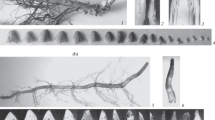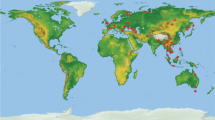Abstract
The structure of monocarpic shoots of some representatives of the Sparganiaceae family (Sparganium emersum Rehm., Sparganium natans L. (subgenus Xanthosparganium), Sparganium erectum L. and Sparganium microcarpum (Neum.) Domin (subgenus Melanosparganium)) has been analyzed with the help of the modular approach. The structure of all three module categories—elementary (EM), universal (UM), and basic (BM)—is described. With a decrease in EM value, all investigated species line up in the following descending order: S. emersum (23) > S. erectum (20) > S. natans (19) > S. microcarpum (18). It is determined that the level of EM similarity between two bur-reed subgenera reaches 30%. The rest of the EM part is specific for certain subgenera, as well as for certain species. It is shown that dissimilarities between different ecological forms of Sparganium are due not to a quantitative EM increase, but to their transformation ability, which improves species adaptation to varying water-level conditions of reservoirs. The UM value in the representatives of both subgenera equals 4; BM values are represented by two similar variants. This was caused by the similarity of habitats of the model species. The special features of the plants on the level of structural–functional organization of different types of monocarpic shoots are shown. Differences in the set of structural–functional zones for particular shoot types were also revealed.
Similar content being viewed by others
References
Belyakov, E.A., Structural-functional zoning of monocarpic shoots in Sparganium microcarpum (Neum.) Domin, in Mater. Vseros. nauch. konf. s mezhdunarodnym uchastiem (k 50-letiyu Kirovskogo otdeleniya Russkogo botanicheskogo obshchestva) “Fundamental’naya i prikladnaya biomorfologiya v botanicheskikh i ekologicheskikh issledovaniyakh” (Proc. All-Russ. Sci. Conf. with International Participation Dedicated to 50th Anniversary of Kirov Branch of the Russian Botanical Society “Fundamental and Applied Biomorphology in Botanical and Ecological Studies”), Kirov: Raduga-Press, 2014, pp. {116–120}.
Belyakov, E.A. and Lapirov, A.G., Morphology of tuberous structures in Sparganium emersum Rehm., in Mater. XVI shkoly-konf. molodykh uchenykh “Biologiya vnutrennikh vod” (Proc. XVI School-Conf. of Young Scientists “Biology of Inland Waters”), Yaroslavl: Print House, 2010, pp. {3–8}.
Borisova, I.V. and Popova, G.A., Diversity of functional-spatial structure of the shoots of perennial plants, Bot. Zh., 1990, vol. 75, no. 10, pp. {1420–1426}.
Gatsuk, L.E., Gemmaxilar plants and the system of subdominant units of their shoot body, Byull. Mosk. O-va. Ispyt. Prir., Otd. Biol., 1974, vol. 79, no. 1, pp. {100–113}.
Grudzinskaya, I.A., Summer tillering in wood plants and its classification, Bot. Zh., 1960, vol. 45, no. 7, pp. {968–978}.
Kuznetsova, T.V., Pryakhina, N.I., and Yakovlev, G.P., Sotsvetiya: morfologicheskaya klassifikatsiya (Morphological Classification of Inflorescences), St. Petersburg: Khim.-Farm. Inst., 1992.
Lapirov, A.G. and Belyakov, E.A., Morphology of vegetative and generative structures of Sparganium microcarpum (Neum.) Raunk., Yarosl. Pedagog. Vestn., 2011, vol. 3, no. 1, pp. {133–138}.
Musina, L.S., Tillering and development of life forms of some rosette-forming herbs, Byull. Mosk. O-va. Ispyt. Prir., Otd. Biol., 1976, vol. 81, no. 6, pp. {123–132}.
Notov, A.A., Module organization as the model object for biological studies, Vestn. Tver. Gos. Univ., Ser. Biol. Ekol., 2008, no. 9, pp. {162–176}.
Papchenkov, V.G., Rastitel’nyi pokrov vodoemov i vodotokov Srednego Povolzh’ya (Vegetation Cover of Reservoirs and Water Channels of Central Volga Region), Yaroslavl: Mezhd. Akad. Biznesa Nov. Tekhnol., 2001.
Savinykh, N.P., Tillering, morphogenesis of Veronica gentianoides Vahl. (Scrophulariaceae) and origin of semirosette herbs, Bot. Zh., 1999, vol. 84, no. 6, pp. {20–31}.
Savinykh, N.P., Rod Veronica: morfologiya i evolyutsiya zhiznennykh form (Genus Veronica: Morphology and Evolution of Life Forms), Kirov: Vyatsk. Gos. Gumanit. Univ., 2006.
Savinykh, N.P., Module organization of the plants, in Ontogeneticheskii atlas rastenii (Ontogenetic Atlas of the Plants), Yoshkar-Ola: Mariel. Gos. Univ., 2007, vol. 5, pp. {15–34}.
Savinykh, N.P., Implementation of the concept of module organization to description of the plant structure, in Sovremennye podkhody k opisaniyu struktury rastenii (Modern Approaches to Description of the Plant Structures), Kirov: Loban’, 2008, pp. {47–69}.
Savinykh, N.P. and Mal’tseva, T.A., Module of the plants as the structure and category, Vestn. Tver. Gos. Univ., Ser. Biol. Ekol., 2008, no. 9, pp. {227–234}.
Semakina, E.V. and Savinykh, N.P., Shoot system and life form of Sparganium emersum Rehm, in Dvenedtsataya molodezhnaya konf. Inst. Biol. Komi Nauch. Tsentra, UrO, Ross. Akad. Nauk “Aktual’nye problemy biologii i ekologii,” Syktyvkar, Rossiya, 4–7 aprelya 2005 g. (Twelfth Conf. of Young Scientists of the Institute of Biology, Komi Scientific Center, Ural Branch, Russian Academy of Sciences “Relevant Problems of Biology and Ecology,” Syktyvkar, Russia, April 4–7, 2005), Syktyvkar: Komi Nauch. Tsentr, UrO, Ross. Akad. Nauk, 2005, pp. {144–146}.
Serebryakov, I.G., Morfologiya vegetativnykh organov vysshikh rastenii (Morphology of Vegetative Organs of Higher Plants), Moscow: Sov. Nauka, 1952.
Serebryakov, I.G., Life forms of higher plants and their study, in Polevaya geobotnika (Field Geobotany), Moscow: Akad. Nauk SSSR, 1964, vol. 3, pp. {146–208}.
Serebryakova, T.I. and Pavlova, N.R., Tillering, rhythm of development, and vegetative reproduction in section Potentilla of genus Potentilla (Rosaceae), Bot. Zh., 1986, vol. 71, no. 2, pp. {154–167}.
Serebryakova, T.I. and Petukhova, L.V., Architecture model and life forms of some herbal Rosaceae, Byull. Mosk. O-va. Ispyt. Prir., Otd. Biol., 1978, vol. 83, no. 6, pp. {51–63}.
Shafranova, L.M., External structure of vegetative organs of the plants, in Uchebno-polevaya praktika po botanike (Practical Field Manual on Botany), Moscow: GEOTAR-Media, 2012, pp. {18–31}.
Troll, W., Die Infloreszenzen, Jena: Gustav Fischer Verlag, 1964, vol. 1.
Yuzepchuk, S.V., Family Sparganiaceae Engl., in Flora SSSR (Flora of the Soviet Union), Leningrad, 1934, vol. 1, pp. {219–229}.
Author information
Authors and Affiliations
Corresponding author
Additional information
Original Russian Text © E.A. Belyakov, A.G. Lapirov, 2015, published in Sibirskii Ekologicheskii Zhurnal, 2015, No. 5, pp. 785–799.
Rights and permissions
About this article
Cite this article
Belyakov, E.A., Lapirov, A.G. Modular and structural–functional organization of G. sparganium L. species in different ecological conditions. Contemp. Probl. Ecol. 8, 647–659 (2015). https://doi.org/10.1134/S1995425515050030
Received:
Accepted:
Published:
Issue Date:
DOI: https://doi.org/10.1134/S1995425515050030




